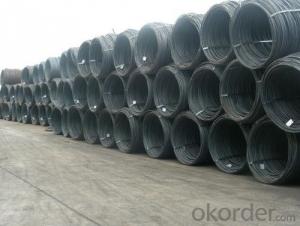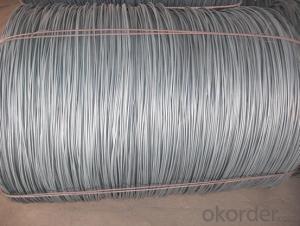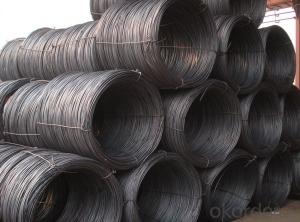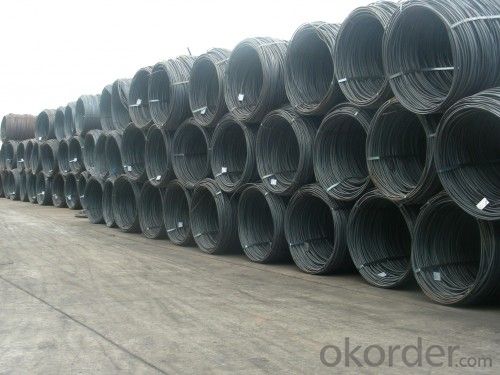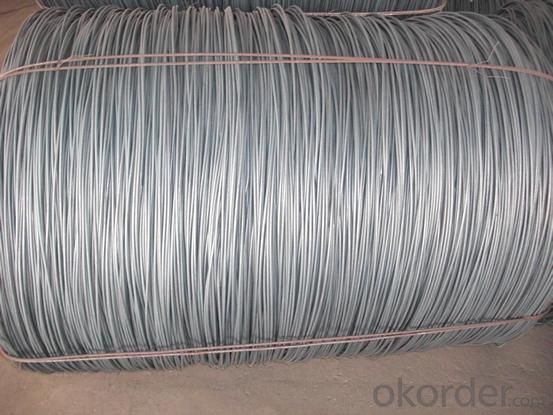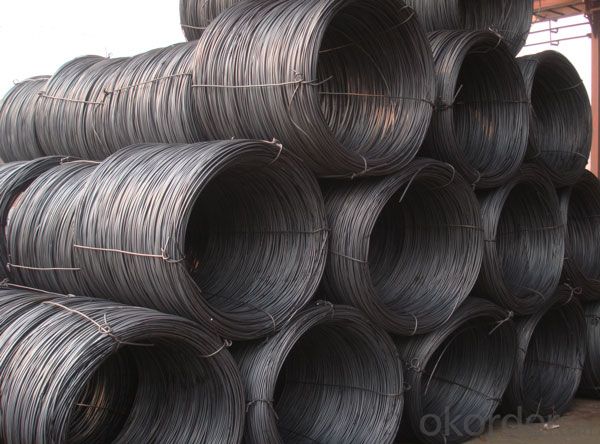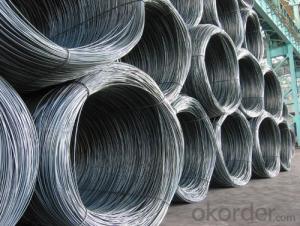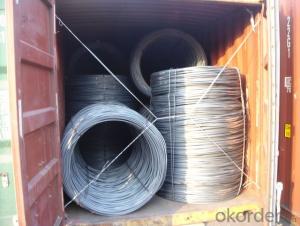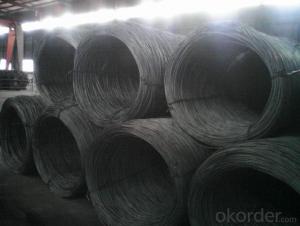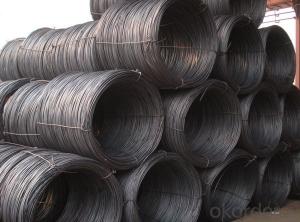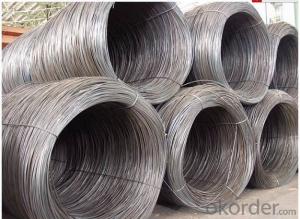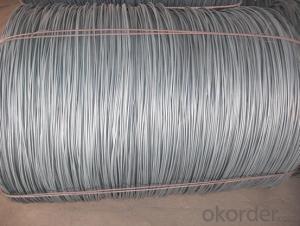Hot Rolled Steel Wire Rod SAE1008B 5.5MM-14MM
- Loading Port:
- Tianjin
- Payment Terms:
- TT or LC
- Min Order Qty:
- 25 m.t.
- Supply Capability:
- 100000 m.t./month
OKorder Service Pledge
OKorder Financial Service
You Might Also Like
Product Description:
OKorder is offering high quality Hot Rolled Steel Wire Rod SAE1008B 5.5MM-14MMat great prices with worldwide shipping. Our supplier is a world-class manufacturer of steel, with our products utilized the world over. OKorder annually supplies products to European, North American and Asian markets. We provide quotations within 24 hours of receiving an inquiry and guarantee competitive prices.
Product Applications:
After hot-rolled the products shaped into coil and delivery as finished product, including round, square, rectangular, hexagonal and so on. Since most of the products are round, it is generally called wire rod. Carbon steel wire rod is widely used in construction and manufacturing. Carbon steel wire rod is mainly used for reinforcement of reinforced concrete and welded structure or reprocessed (roberts , nail, etc.) materials, especially used to produce wire drawing, welding electrode, nails, spring, electronic, precise machinery parts and so on.
Product Advantages:
OKorder's Hot Rolled Steel Wire Rod SAE1008B 5.5MM-14MM are durable, strong, and resist corrosion.
Main Product Features:
· Premium quality
· Prompt delivery & seaworthy packing (30 days after receiving deposit)
· Corrosion resistance
· Can be recycled and reused
· Mill test certification
· Professional Service
· Competitive pricing
Product Specifications:
Manufacture: Hot rolled
Grade: SAE1008 SAE 1006
Certificates: ISO, SGS, BV, CIQ
Diameter: 5.5mm, 6.5mm, 7mm,8mm,9mm,10mm,12mm,14mm, as per customer request
Packaging: Export packing, nude packing, bundled
Grade | Chemical Composition (%) | |||||
C | Mn | S | P | Si | B | |
SAE1008B | 0.10max | 0.32max | 0.045max | 0.040max | 0.30max | 0.0008min |
Mechanical properties | ||||||
Yield strength(N/mm2) | Tensile strength(N/mm2) | Elongation (%) | ||||
≥195 | 350-380 | ≥32 | ||||
FAQ:
Q1: How do we guarantee the quality of our products?
A1: We have established an advanced quality management system which conducts strict quality tests at every step, from raw materials to the final product. At the same time, we provide extensive follow-up service assurances as required.
Q2: How soon can we receive the product after purchase?
A2: Within three days of placing an order, we will begin production. The specific shipping date is dependent upon international and government factors, but is typically 7 to 10 workdays.
Q3: What makes stainless steel stainless?
A3: Stainless steel must contain at least 10.5 % chromium. It is this element that reacts with the oxygen in the air to form a complex chrome-oxide surface layer that is invisible but strong enough to prevent further oxygen from "staining" (rusting) the surface. Higher levels of chromium and the addition of other alloying elements such as nickel and molybdenum enhance this surface layer and improve the corrosion resistance of the stainless material.
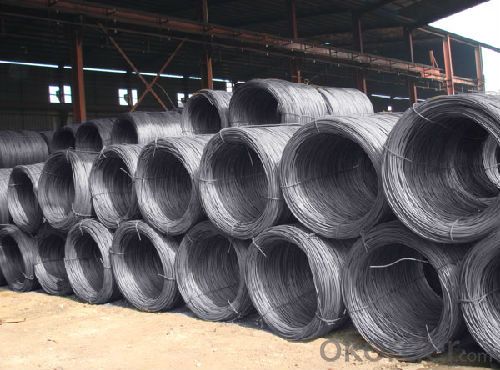

- Q: How is steel wire rod protected from rust and corrosion during storage?
- Steel wire rod is protected from rust and corrosion during storage by applying a coating or a layer of protective oil on its surface. This prevents moisture and oxygen from coming into contact with the steel, which helps to minimize the risk of rust and corrosion. Additionally, proper storage conditions, such as keeping the wire rod in a dry and well-ventilated area, also play a crucial role in protecting it from rust and corrosion.
- Q: What are the major trends in the steel wire rod industry?
- The steel wire rod industry is currently being shaped by several significant trends. Firstly, there is a growing demand for steel wire rods across various industries such as construction, automotive, and manufacturing. This increased demand can be attributed to factors like population growth, urbanization, and global infrastructure development. Secondly, there are notable technological advancements taking place within the industry. These innovations aim to improve manufacturing processes, enhance wire rod quality, and reduce production costs. Automation, robotics, and data analytics are among the key technological trends that are revolutionizing the industry. Additionally, there is a shift towards more sustainable practices in the steel wire rod industry due to increasing environmental concerns. Companies are adopting energy-efficient technologies, reducing emissions, and implementing recycling programs to minimize their environmental impact. This trend is driven by both regulatory requirements and the industry's commitment to sustainability. Furthermore, the industry is experiencing market consolidation, as larger companies acquire smaller players and form strategic partnerships. This consolidation is driven by the need to optimize production capacities, expand global reach, and achieve economies of scale. Mergers and acquisitions are reshaping the competitive landscape of the industry. Lastly, steel wire rod manufacturers are increasingly focusing on product diversification to remain competitive. They are developing a wide range of wire rod products with varying specifications to cater to the diverse needs of different industries. Customization and flexibility in manufacturing are becoming crucial factors for success in the industry. Overall, these trends in the steel wire rod industry are driving it towards a more efficient, sustainable, and customer-centric future.
- Q: How is steel wire rod used in the manufacturing of automotive suspension springs?
- Steel wire rod is used in the manufacturing of automotive suspension springs as it provides the necessary strength, durability, and flexibility required to absorb shocks and vibrations. The wire rod is first shaped into a coil or helix, which is then heat-treated to enhance its mechanical properties. These springs are then used in the suspension system to support the vehicle's weight, maintain stability, and improve ride comfort by absorbing impacts from uneven road surfaces.
- Q: How are steel wire rods used in the production of barbed fences?
- Due to their strength and durability, steel wire rods play a crucial role in the manufacturing of barbed fences. These wire rods serve as the fundamental material for producing the barbed wire used for constructing these fences. The process begins by passing the steel wire rods through a series of dies, which reduces their diameter and increases their length. This wire drawing process ensures that the wire rods have a consistent thickness and strength. Once the desired thickness is achieved, the wire rods are twisted together to form a sturdy and resilient wire strand. This wire strand is then modified by adding sharp and pointed barbs at regular intervals. Typically, the barbs are created by cutting the wire strand and bending the cut ends outward, resulting in a hook-like structure. This design effectively deters trespassers and animals from crossing the fence. The resulting barbed wire is then wound onto rolls, making it easy to unroll and attach to fence posts or other support structures during installation. The sharp barbs on the wire act as a deterrent, making it challenging for intruders or livestock to pass through the fence without getting caught or injured. In conclusion, steel wire rods are essential for producing barbed fences due to their strength, durability, and flexibility. The addition of barbs to the wire strand further enhances the security provided by these fences, making them widely used in various applications, including agricultural fencing, military installations, and perimeter security.
- Q: What are the common production processes for tungsten-coated steel wire rod?
- The common production processes for tungsten-coated steel wire rod include wire drawing, cleaning and degreasing, tungsten coating, and heat treatment.
- Q: How are steel wire rods used in the manufacturing of piano strings?
- Steel wire rods are used in the manufacturing of piano strings as they provide the necessary strength and flexibility required for producing high-quality and durable strings.
- Q: What are the different mechanical tests conducted on steel wire rod?
- There are several mechanical tests conducted on steel wire rods to evaluate their quality and performance. These tests include tensile strength testing, which measures the maximum load the wire can withstand before breaking; yield strength testing, which determines the point at which the wire starts to deform permanently under stress; elongation testing, which measures the wire's ability to stretch before breaking; and hardness testing, which evaluates the wire's resistance to indentation or scratching. Additionally, other tests such as impact testing and fatigue testing may also be performed to assess the wire's durability and ability to withstand sudden or repetitive loads.
- Q: How are steel wire rods used in the manufacturing of cables?
- Cables rely heavily on steel wire rods, as they are a crucial component in their production. These rods act as the core material and provide the required strength and durability for different applications. To initiate the cable manufacturing process, careful selection of steel wire rods is essential. Factors such as quality and specific properties including tensile strength, ductility, and corrosion resistance are considered. These characteristics guarantee that the final product meets the desired standards and performs effectively in its intended application. Once the suitable steel wire rods are chosen, they undergo various manufacturing processes like drawing and stranding. Initially, the rods are pulled through a series of dies to decrease their diameter and increase their length. This process, known as wire drawing, enhances the tensile strength and flexibility of the steel wire, ensuring its ability to endure the stresses and strains encountered during cable usage. Following wire drawing, the drawn steel wires are intertwined to form the cable. Multiple steel wires are intricately arranged in a compact and uniform manner through stranding. This creates a strong and flexible structure. The number of wires and their arrangement in the stranding process depend on the specific cable design and application requirements. Furthermore, steel wire rods are often coated or treated with protective materials to enhance their performance. These coatings may include galvanization to prevent corrosion, lubricants to enhance flexibility, or insulation materials to provide electrical insulation properties. These treatments further augment the durability, longevity, and functionality of the cables. In conclusion, steel wire rods play a crucial role in cable manufacturing, providing the necessary strength, flexibility, and durability for dependable and efficient transmission of various signals, power, or data.
- Q: How is steel wire rod used in the production of wire mesh screens?
- Steel wire rod is a crucial component in the production of wire mesh screens. Wire mesh screens are widely used in various industries, such as construction, mining, agriculture, and manufacturing, for their durability and versatility. The steel wire rod is the starting material for manufacturing wire mesh screens. It is typically made from low carbon steel and undergoes a series of processes to transform it into the final product. First, the steel wire rod is drawn through a series of dies to reduce its diameter and increase its length. This process, known as wire drawing, results in long continuous strands of thin steel wire. These wire strands are then further processed through a series of machines to give them the required shape and dimensions. The wire is woven or welded together to form a grid-like pattern, creating the wire mesh screen. The wire mesh screens can be customized with different opening sizes, wire diameters, and weaving patterns to meet specific application requirements. For instance, screens used in construction applications may have larger openings to allow for better airflow, while screens used in mining may have smaller openings to filter out particles of specific sizes. The steel wire rod used in the production of wire mesh screens ensures the screens are strong and durable. Steel is known for its high tensile strength, which makes the screens capable of withstanding heavy loads, impacts, and harsh environmental conditions. Additionally, steel wire rod provides excellent corrosion resistance, which is crucial for wire mesh screens used in outdoor applications or industries where exposure to moisture, chemicals, or other corrosive substances is common. In conclusion, steel wire rod plays a vital role in the production of wire mesh screens by providing the necessary strength, durability, and corrosion resistance. These screens are widely used in various industries for their versatility and ability to meet specific application requirements.
- Q: How are steel wire rods used in the manufacturing of welding wires for joining metals?
- Steel wire rods are an essential element in the production of welding wires used to join metals. These wire rods are the main raw material for creating welding wires, which find extensive application in various industries for welding and fabrication purposes. Typically, high-quality carbon or alloy steel is employed to manufacture the steel wire rods used for welding wire production. These rods undergo a series of processes, including hot rolling, drawing, and sometimes cold drawing, in order to achieve the desired dimensions and mechanical properties. Following the manufacturing of steel wire rods, additional procedures are carried out to convert them into welding wires. These procedures involve cleaning, descaling, and coating. The cleaning process eliminates any impurities or contaminants present on the surface of the wire rods. Descaling ensures a clean and smooth wire surface by removing mill scale, rust, or oxide layers. Coating, the final step, involves the application of specific chemicals or alloys to enhance the welding characteristics and performance of the wire surface. The welding wires derived from steel wire rods possess several properties that make them highly suitable for metal joining through welding. These wires exhibit exceptional tensile strength, enabling them to endure high temperatures and mechanical stresses during the welding process. Additionally, they exhibit good ductility, allowing for easy bending, shaping, or manipulation during welding. Furthermore, the surface coating on the welding wire provides additional advantages. It acts as a protective barrier during welding, safeguarding the molten weld pool against contamination from atmospheric gases such as oxygen and nitrogen, which could adversely impact the weld quality. The coating also promotes arc stability, ensuring a smooth and consistent welding operation. In conclusion, steel wire rods play a critical role in the production of welding wires for metal joining. They serve as the initial material, undergoing various processes to create high-quality welding wires with exceptional mechanical properties and enhanced welding characteristics. These welding wires are extensively used in industries such as construction, automotive, aerospace, and manufacturing, facilitating efficient and reliable metal joining through welding procedures.
Send your message to us
Hot Rolled Steel Wire Rod SAE1008B 5.5MM-14MM
- Loading Port:
- Tianjin
- Payment Terms:
- TT or LC
- Min Order Qty:
- 25 m.t.
- Supply Capability:
- 100000 m.t./month
OKorder Service Pledge
OKorder Financial Service
Similar products
Hot products
Hot Searches
Related keywords
